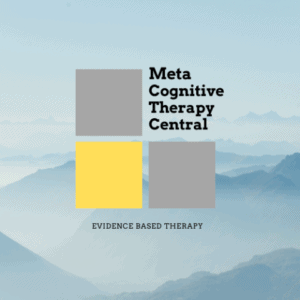
Up to 10% of the general population hears voices and sees things that aren’t really present (hallucinations), but not everyone develops a psychotic episode. It seems that worrying is connected with psychotic experiences together with positive and negative metacognitions about hallucinations.
Metacognitive therapy treats psychosis the same way it treats generalized anxiety disorder: by reducing worry, worry about worry, and changing beliefs that worrying is out of one’s control and that delusional thoughts can cause harm.
Since hallucinations are exaggerations of normal experiences, worrying, according to professor Adrian Wells, exacerbates them to the extent that they become distressing for the sufferer.
Hallucinations —such as hearing voices— and delusions don’t necessarily have to be viewed negatively, and many people learn to adapt to them.
What is psychosis?
Psychosis is a condition where people experience unusual beliefs (delusions) and abnormal perceptual experiences (hallucinations)(10). Psychosis is a symptom that affects thoughts, feelings, and behaviors, and the diagnoses that include psychosis are, amongst others, schizophrenia, brief psychotic disorder, and delusional disorder.
Psychosis positive symptoms:
- Delusions (an often false belief that is held with high conviction, for example, being persecuted by the police)
- Hallucinations (hearing voices and sounds, seeing things that others can’t see, smelling things, and sensing things like, for example, insects crawling on the skin)
- Disorganized speech (for example, making up words)
- Disorganized or catatonic behavior (for example, a lack of movement, agitation, confusion, and restlessness)
Delusions and hallucinations (hearing voices and seeing things that other people don’t) are positive symptoms as they add something to a person’s experiences.
Psychosis negative symptoms:
- flattened affect
- deprivation of speech
- apathy
Reduced motivation and reduced feelings are negative symptoms because they are experiences that are taken away from a person.
According to research, hallucinations and delusions might only be a problem if they cause significant distress and impair functioning.
Several other mental disorders include psychosis. To learn more about psychosis, go here.
This content is for informational use only and is not intended to be a substitute for professional advice, diagnosis, or treatment by an MCT-I certified therapist.
What is MCT for Psychosis?
Metacognitive therapy (MCT) for psychosis focuses on treating positive symptoms by reducing worry and helping patients re-interpret their hallucinations and delusions. This is achieved by changing metacognitions (metacognitive beliefs)(3).
In MCT, the effort and time spent dealing with hallucinations and delusions cause people with psychosis to suffer greatly. This notion is backed up by research showing that people with psychotic experiences have significant anxiety disorders, from post-traumatic stress to social anxiety, typically maintained by extended worrying (2).
Therefore, Wells, the founder of Metacognitive therapy, suggests that the goal of MCT for psychosis is to reduce worry and teach patients to manage their positive symptoms differently, which does not include worrying about them, acting on them, or suppressing them. This is reinforced through changed metacognitive beliefs.

The Metacognitive model of psychosis
According to Adrian Wells, the CAS (which is short for the Cognitive Attentional Syndrome) intensifies the positive symptoms of psychosis. Wells founded the Metacognitive model of psychosis and suggested that the following strategies maintain psychosis:
CAS in Psychosis
1. Worry & Rumination (about delusions)
2. Analysing meanings of thoughts and hallucinations
3. Battling voices
4. Suppressing thoughts
5. Cultivating benevolent voices
6. Threat monitoring (watching the street, listening
in, monitoring for thoughts/voices, looking for early
symptoms).
7. Alcohol, drugs, self-harm, self-punishment
For example, a patient suffering from a Psychotic episode will hear voices and experience a triggering thought: “Is this a secret message?”
The patient will then analyze the meaning of the thought, which will cause discomfort because rumination and worry prolong negative experiences in the body.
The patient begins to analyze the meaning of the voices in the first place because of his beliefs about thoughts, also called metacognitive beliefs.
Metacognition means thinking about thinking, and metacognitive beliefs mean what we believe about our thoughts.
Wells tested what predicts hallucinations in patients with psychosis. He found that patients with psychosis have different types of metacognitive beliefs, both positive and negative. The negative metacognitive beliefs consist of both uncontrollability and danger metacognitive beliefs.
Metacognitive beliefs about uncontrollability
So if the patient from the example above has uncontrollability metacognitive beliefs, he thinks he can’t stop worrying and analyzing his hallucinations and delusions. He also might believe that his brain is damaged from having prior psychotic episodes.
Examples of uncontrollability metacognitive beliefs are:
“I can’t stop worrying about my hallucinations.”
Metacognitive beliefs about danger
The patient can also have danger metacognitive beliefs about the importance of thoughts, mind-reading, and mental powers. If the psychotic patient also has danger metacognitive beliefs, he thinks that having specific thoughts can harm him and that thoughts can be transferred into his head from outside to control him.
Examples of danger metacognitive beliefs are:
“Thoughts can be broadcasted”
Metacognitive beliefs about the helpfulness of thoughts (positive beliefs)
It seems that 50% of psychiatric patients with psychosis find their hallucinations relaxing, soothing, and providing companionship. This could prove that some patients with psychosis have positive metacognitive beliefs (that thinking about hallucinations is helpful and positive)(4).
A study by Morrison, Wells, and Nothard in 2002 investigated what predicts predisposition to hallucinations in people who don’t have psychosis. They discovered that positive metacognitive beliefs about voices were associated with vulnerability to hearing voices. They also found that negative metacognitive beliefs about hearing voices determined how much stress people experience when hearing voices.
It seems that It is because of the negative metacognitive beliefs that patients think that their psychotic symptoms are out of their control and dangerous, which causes significant distress.
Hearing voices has in the past been interpreted as either demonic possession or religious inspiration. In the last 100 years, hearing voices has been attributed to psychiatric illness.
Summary
Hallucinations are not necessarily a cause of distress by themselves. Instead, metacognitive beliefs can determine whether hallucinations will lead to distress for people suffering from psychosis.
What causes hallucinations?
There is consensus among psychologists that hallucinations are exaggerations of normal experiences. Research suggests that auditory hallucinations might be a form of internal speech and that sometimes, hallucinations are old memories remembered (7).
Hallucinations can also be caused by:
•Drug induced
•Sleep deprivation
•Hypnogogic phenomena (waking dreams)
•Fever related
•Illness related e.g. Parkinson’s disease
However, there is some evidence from the literature that hearing voices is a normal psychological phenomenon. For example, studies show that 37-39% of college students report having auditory hallucinations, yet they did not report suffering from any psychiatric illness.
Other studies have shown that 30% of different populations experience hearing their thoughts spoken out loud.
Hallucinations are sensory perceptions in the absence of external stimuli, meaning that when people hallucinate, they experience things that are not real. Hallucinations can involve any of our senses like vision, hearing, smell, touch, and taste.
Auditory hallucinations: Hearing voices and sounds. Auditory hallucinations (hearing voices and sounds) are experienced as if hearing external speech. Evidence from neuroimaging suggests that auditory hallucinations in both psychotic and nonpsychotic patients activate the same language areas of the brain (Sommer 2012). According to those who suffer from auditory hallucinations (hearing voices), the content of the voices can be issuing commands, echoing the person’s thoughts, and running commentary on everyday situations. However, for those who suffer from psychotic disorders (for example, schizophrenia), the voices are hostile, threatening, and degrading and can be two or more voices speaking amongst themselves about the person hearing them.
Visual hallucination: (seeing things). Visual hallucinations can range from seeing shadows, insects, and animals in the room, to seeing faces that move and mimic one’s thoughts. and colors.
How is psychosis usually treated?
According to the NICE guidelines, “Early intervention in psychosis services should aim to provide a full range of pharmacological, psychological, social, occupational and educational interventions for people with psychosis, consistent with this guideline.”(12)
Furthermore, they recommend oral antipsychotic medication along with psychological interventions consisting of:
- Family therapy intervention that consists of at least 10 planned sessions
- Cognitive-behavioral therapy (CBT) on a one-to-one basis for at least 16 planned sessions. The CBT treatment has to focus on:
- promoting alternative ways of coping with the targetted symptom
- reducing distress
- improving functioning
How effective is CBT for psychosis?
In the last 20 years, about 50 randomized controlled trials have shown that CBT for psychosis reduces positive symptoms, negative symptoms, general functioning, and symptoms of depression.
However, a recent meta-analysis(5) (a statistical analysis that combines the results of multiple scientific studies) from 2018 examined the effect of CBT on the quality of life and functioning of patients with psychosis. They found that although the quality of life improved a little right after CBT, this effect was not maintained when they followed up several months later.
The authors also point out similar results for CBT for delusions; that CBT is more effective in reducing delusions than usual treatment for psychosis, but this effect does not stay stable after 10 months.
The authors, therefore, conclude that CBT for psychosis “…is not superior to other effective interventions, neither at end-of-therapy nor after a follow-up period.” They also claim that the NICE guidelines have based their guides on outdated studies “NICE have still failed to update their meta-analyses, which contain no trials post-2008.“

Research on MCT for psychosis
There is some evidence from MCT research (1) (2) (3) that the content of hallucinations is not as important as the convictions about them. Beliefs about the power and purpose of hallucinations seem to guide how people deal with them.
A study from 2007 (14) showed that psychotic patients used more avoidance and control strategies and were more occupied with their hallucinations than those who had hallucinations but weren’t troubled by them. Constant avoidance of hallucinations prevents patients from disconfirming that hallucinations don’t hold power over someone.
This is in line with the work of MCT for psychosis. MCT does not directly challenge the patients’ thoughts (for example, whether someone is surveilling you or not) but focuses on the process of thinking (does thinking this make it true?).
MCT research appears to show potential in reducing psychotic-like experiences, anxiety, and depression and increase functioning for people with psychosis. These studies have also demonstrated the role of metacognitive beliefs in developing and maintaining Psychosis.
Here is an overview (but not exhaustive) of some of the MCT research for psychotic disorders:
| Who did the study | Type of study | What did they study | What did they find | Limitations of the study |
| Parker SK, Mulligan LD, Milner P, Bowe S and Palmier-Claus JE (2020) Metacognitive Therapy for Individuals at High Risk of Developing Psychosis: A Pilot Study. Front. Psychol. 10:2741. doi: 10.3389/fpsyg.2019.02741 | Case series of MCT | Is MCT a feasible therapy for young people at high risk for developing psychosis? | – Clinically significant reductions in psychotic-like experiences (Non-Bizarre ideas, Perceptual abnormalities, disorganized speech) -Significant reductions in anxiety and depression – Significant improvement in functioning | The small sample size (only a few people participated) makes it difficult to interpret precise results |
| Hutton, P, Morrison, AP, Wardle, M & Wells, A (2014) ‘Metacognitive Therapy in Treatment-Resistant Psychosis: A Multiple-Baseline Study’, Behavioural and Cognitive Psychotherapy, vol. 42, no. 2, pp. 166- https://doi.org/10.1017/S1352465812001026 | Case series of MCT | Can a brief course of MCT work in schizophrenia (reducing both delusions and hallucinations) through 12 weekly 1-hour treatment sessions | MCT was associated with a large, clinically significant reduction in the severity of delusions for 2 out of our 3 participants. 1 participant did not improve | The study had only 3 participants, and those who made assessments were not blinded (which can inflate results) |
| Morrison A & Wells A. (2007). Relationships between worry, psychotic experiences and emotional distress in patients with schizophrenia spectrum diagnoses and comparisons with anxious and non-patient groups. Behaviour research and therapy. 45. 1593-600. 10.1016/j.brat.2006.11.010 | Testing whether worry is associated with psychotic experiences | Testing whether worry is associated with psychotic experiences and does worry by itself leads to anxiety independent of psychosis | – Worrying is what leads to distress in people who have psychosis – Targetting worry in the treatment of psychosis will reduce distress and may alleviate psychotic experiences | Cross-sectional study and based on self-report (it only captures a specific point in time, based on people completing rating scales) |
| Morrison A, French P, Wells A. (2007) Metacognitive beliefs across the continuum of psychosis: Comparisons between patients with psychotic disorders, patients at ultra-high risk and non-patients. Behaviour Research and Therapy 45 (2007) 2241–2246 | Testing whether metacognitive beliefs are associated with developing and maintaining psychotic disorders | Do people with psychotic disorders, people at risk of developing psychosis, and healthy people have different metacognitive beliefs | – Both patients with psychotic disorders and those at high risk had higher levels of metacognitive beliefs. -Negative metacognitive beliefs predispose people to anxiety, and psychosis occurs when positive metacognitive beliefs are also strong | The participants were not tested for depression and anxiety, which makes it difficult to decide whether the high levels of metacognitive beliefs were only due to anxiety and depression instead of psychosis |
Summary
Metacognitive therapy could prove a feasible and brief treatment for psychotic disorders. Its strength lies in the understanding that metacognitive beliefs maintain psychotic experiences and that changing metacognition could potentially reduce both positive and negative symptoms. This is an alternative to treatments that focus on the content of hallucinations and delusions, which are strongly held by some psychotic patients, making them harder to change.
Metacognitive therapy research for psychosis is still in its beginning, and it needs bigger trials to assess its effect on psychotic disorders.
References
- Parker SK, Mulligan LD, Milner P, Bowe S and Palmier-Claus JE (2020) Metacognitive Therapy for Individuals at High Risk of Developing Psychosis: A Pilot Study. Front. Psychol. 10:2741. doi: 10.3389/fpsyg.2019.02741
- Morrison AP, Wells A. Relationships between worry, psychotic experiences and emotional distress in patients with schizophrenia spectrum diagnoses and comparisons with anxious and non-patient groups. Behav Res Ther. 2007 Jul;45(7):1593-600. doi: 10.1016/j.brat.2006.11.010. Epub 2007 Mar 23. PMID: 17367750.
- Wells A. (2021). Personal communication. Copenhagen.
- Morrison, A. P., Wells, A., & Nothard, S. (2002). Cognitive and emotional predictors of predisposition to hallucinations in non-patients. British Journal of Clinical Psychology, 41(3), 259–270. https://doi.org/10.1348/014466502760379127
- Laws, K.R., Darlington, N., Kondel, T.K. et al. Cognitive Behavioural Therapy for schizophrenia – outcomes for functioning, distress and quality of life: a meta-analysis. BMC Psychol 6, 32 (2018). https://doi.org/10.1186/s40359-018-0243-2
- Mehl S, Werner D and Lincoln TM (2015) Does Cognitive Behavior Therapy for psychosis (CBTp) show a sustainable effect on delusions? A meta-analysis. Front. Psychol. 6:1450. doi: 10.3389/fpsyg.2015.01450
- Sommer IE, de Kort GA, Meijering AL, Dazzan P, Hulshoff Pol HE, Kahn RS, van Haren NE. How frequent are radiological abnormalities in patients with psychosis? A review of 1379 MRI scans. Schizophr Bull. 2013 Jul;39(4):815-9. doi: 10.1093/schbul/sbs037. Epub 2012 Mar 13. PMID: 22416264; PMCID: PMC3686442.
- Morrison AP, Wells A, Nothard S. Cognitive factors in predisposition to auditory and visual hallucinations. Br J Clin Psychol. 2000 Mar;39(1):67-78. doi: 10.1348/014466500163112. PMID: 10789029.
- Photo by Isai Ramos – Unsplash
- The Diagnostic and Statistical Manual of Mental Disorders (5th ed.; DSM–5; American Psychiatric Association, 2013)
- Photo by Pawel Szvmanski – Unsplash
- National Institute for Health and Care Excellence (NICE,2013) https://www.nice.org.uk/guidance/cg178/chapter/1-Recommendations#first-episode-psychosis-2
- Photo by Liza Polyanskaya – Unsplash
- M. R. Broome, L. C. Colins, I. Valli, J. B. Woolley, P. Tabraham, C.Brett, L. Valmaggia, E. Peters, P. A. Garety, and P. K. McGuire (2007). Delusion formation and reasoning biases in those at clinical high risk for psychosis. British Journal of Psychiatry, BJP 2007, 191:s38-s42. DOI: 10.1192/bjp.191.51.s38
- Hutton, P., Morrison, A. P., Wardle, M., & Wells, A. (2014). Metacognitive Therapy in Treatment-Resistant Psychosis: A Multiple-Baseline Study. Behavioural and Cognitive Psychotherapy, 42(2), 166-185.10.1017/S1352465812001026
